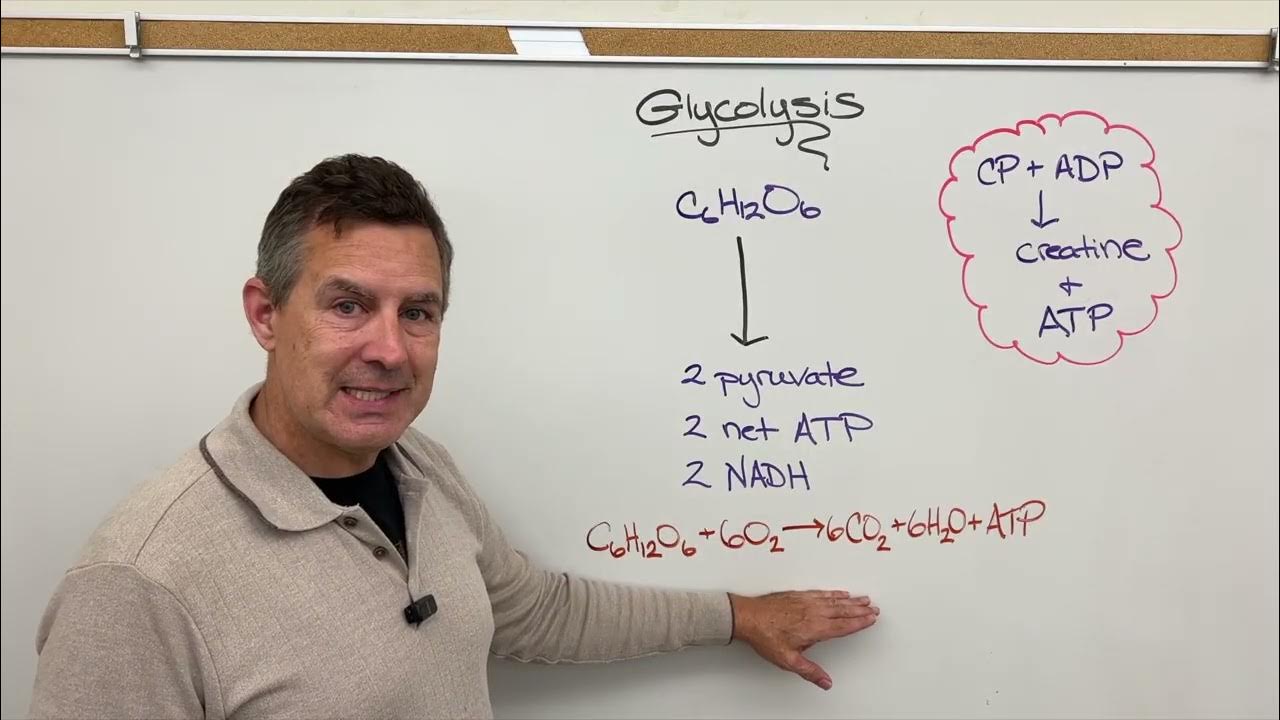Cellular Respiration (Electron Transport Chain) - animated
Summary
TLDRThis video explains the process of oxidative phosphorylation in cellular respiration. It describes how glucose is oxidized in the mitochondria during glycolysis and the Krebs cycle, reducing coenzymes NAD+ and FAD to NADH + H+ and FADH2. These coenzymes transfer electrons to the electron transport chain, moving protons across the membrane and generating a proton motive force. The cytochrome C oxidase complex transfers electrons to oxygen, forming water. Protons re-enter the matrix through ATP synthase, using the energy from their movement to synthesize ATP. This entire process is referred to as oxidative phosphorylation.
Takeaways
- 😀 Glucose oxidation occurs during glycolysis and the Krebs cycle.
- 😀 Coenzymes NAD+ and FAD are reduced to NADH + H+ and FADH2 during glucose metabolism.
- 😀 NADH + H+ transfers electrons to electron carrier proteins in the mitochondria.
- 😀 Protons (H+) are transferred across the mitochondrial membrane as electrons move down the electron transport chain.
- 😀 Electrons are passed from cytochrome to cytochrome within the electron transport chain.
- 😀 Cytochrome c transfers electrons to the cytochrome c oxidase complex.
- 😀 The cytochrome c oxidase complex transfers electrons from cytochrome c to oxygen, producing water as a byproduct.
- 😀 Protons are pumped across the membrane, creating a proton motive force (PMF).
- 😀 The mitochondrial membrane is impermeable to ions, so protons re-enter the matrix through ATP synthase.
- 😀 The movement of protons through ATP synthase generates the energy needed to synthesize ATP from ADP and phosphate.
- 😀 This ATP formation process is called oxidative phosphorylation.
Q & A
What coenzymes are involved in glucose oxidation during glycolysis and the Krebs cycle?
-The coenzymes involved are NAD+ and FAD, which are reduced to NADH + H+ and FADH2, respectively.
Where does the reduction of NAD+ and FAD occur in the cell?
-The reduction of NAD+ and FAD occurs in the mitochondria during glycolysis and the Krebs cycle.
What happens to the electrons from NADH and FADH2 during cellular respiration?
-The electrons from NADH and FADH2 are transferred to electron carrier proteins in the electron transport chain.
What role do protons play in the electron transport chain?
-Protons (H+) are transferred across the membrane as electrons move through the electron transport chain, creating a proton gradient.
How are electrons transferred along the electron transport chain?
-Electrons are transferred from cytochrome to cytochrome along the electron transport chain.
What is the function of cytochrome c in the electron transport chain?
-Cytochrome c transfers electrons to the cytochrome c oxidase complex.
What happens at the cytochrome c oxidase complex?
-The cytochrome c oxidase complex transfers electrons from cytochrome c to oxygen, which is the terminal electron acceptor, resulting in the formation of water.
How does the electron transport chain contribute to proton motive force?
-The transfer of protons across the membrane during electron transport generates a proton motive force across the mitochondrial membrane.
What role does ATP synthase play in oxidative phosphorylation?
-ATP synthase allows protons to re-enter the mitochondrial matrix, and the energy from this movement is used to synthesize ATP from ADP and phosphate.
What is oxidative phosphorylation?
-Oxidative phosphorylation is the process of ATP formation using the energy from the movement of protons through ATP synthase, driven by the proton motive force.
Outlines

此内容仅限付费用户访问。 请升级后访问。
立即升级Mindmap

此内容仅限付费用户访问。 请升级后访问。
立即升级Keywords

此内容仅限付费用户访问。 请升级后访问。
立即升级Highlights

此内容仅限付费用户访问。 请升级后访问。
立即升级Transcripts

此内容仅限付费用户访问。 请升级后访问。
立即升级5.0 / 5 (0 votes)






